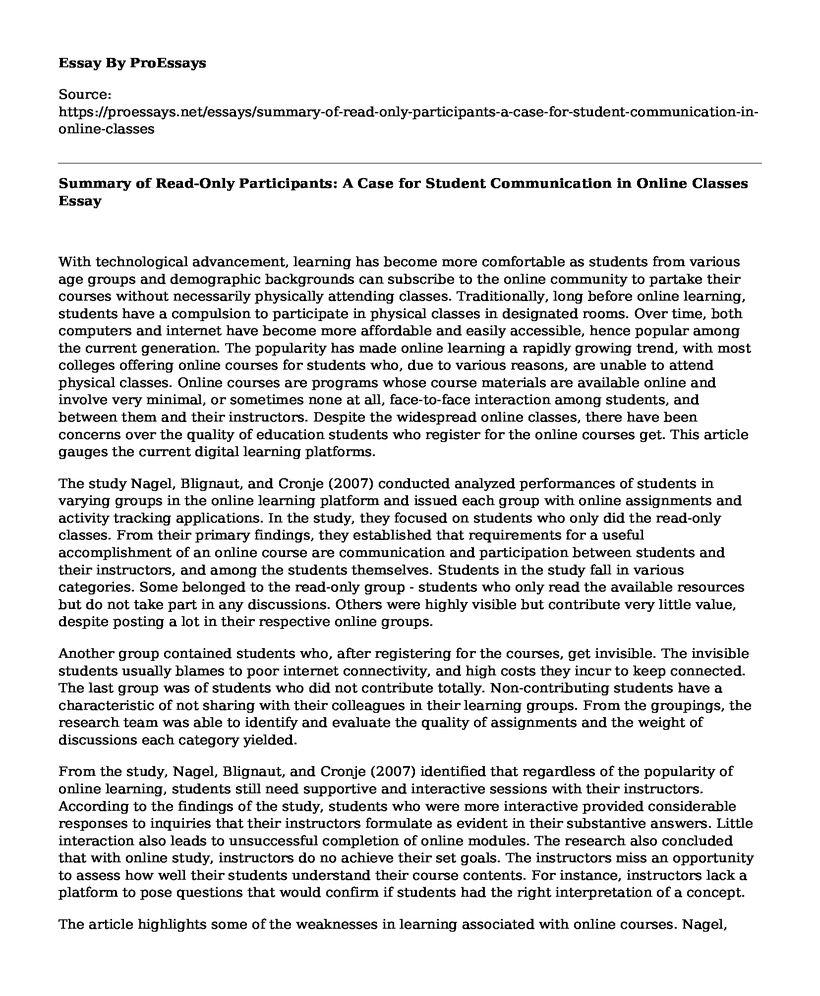With technological advancement, learning has become more comfortable as students from various age groups and demographic backgrounds can subscribe to the online community to partake their courses without necessarily physically attending classes. Traditionally, long before online learning, students have a compulsion to participate in physical classes in designated rooms. Over time, both computers and internet have become more affordable and easily accessible, hence popular among the current generation. The popularity has made online learning a rapidly growing trend, with most colleges offering online courses for students who, due to various reasons, are unable to attend physical classes. Online courses are programs whose course materials are available online and involve very minimal, or sometimes none at all, face-to-face interaction among students, and between them and their instructors. Despite the widespread online classes, there have been concerns over the quality of education students who register for the online courses get. This article gauges the current digital learning platforms.
The study Nagel, Blignaut, and Cronje (2007) conducted analyzed performances of students in varying groups in the online learning platform and issued each group with online assignments and activity tracking applications. In the study, they focused on students who only did the read-only classes. From their primary findings, they established that requirements for a useful accomplishment of an online course are communication and participation between students and their instructors, and among the students themselves. Students in the study fall in various categories. Some belonged to the read-only group - students who only read the available resources but do not take part in any discussions. Others were highly visible but contribute very little value, despite posting a lot in their respective online groups.
Another group contained students who, after registering for the courses, get invisible. The invisible students usually blames to poor internet connectivity, and high costs they incur to keep connected. The last group was of students who did not contribute totally. Non-contributing students have a characteristic of not sharing with their colleagues in their learning groups. From the groupings, the research team was able to identify and evaluate the quality of assignments and the weight of discussions each category yielded.
From the study, Nagel, Blignaut, and Cronje (2007) identified that regardless of the popularity of online learning, students still need supportive and interactive sessions with their instructors. According to the findings of the study, students who were more interactive provided considerable responses to inquiries that their instructors formulate as evident in their substantive answers. Little interaction also leads to unsuccessful completion of online modules. The research also concluded that with online study, instructors do no achieve their set goals. The instructors miss an opportunity to assess how well their students understand their course contents. For instance, instructors lack a platform to pose questions that would confirm if students had the right interpretation of a concept.
The article highlights some of the weaknesses in learning associated with online courses. Nagel, Blignaut, and Cronje (2007) suggest that even though technology had made learning easy, it deprives both instructors and students of vital elements of learning, leading to poor outcomes of the process, compared to the traditional learning technology. The editorial, therefore, suggests adjustments in online course modules to incorporate specific key learning components from the traditional system.
Reference
Nagel, L., Blignaut, A. S., & Cronje, J. C. (2009). Read-Only Participants: A Case for Student Communication in Online Classes. Interactive Learning Environments, 17(1), 37-51.
Cite this page
Summary of Read-Only Participants: A Case for Student Communication in Online Classes. (2022, Sep 26). Retrieved from https://proessays.net/essays/summary-of-read-only-participants-a-case-for-student-communication-in-online-classes
If you are the original author of this essay and no longer wish to have it published on the ProEssays website, please click below to request its removal:
- Stereotyping of Masculinity - Term Paper Example
- Child Behavioral Health Essay
- Practicing Through Self-Regulation Program Paper Example
- The Peloponnesian and Delian Leagues: Ancient Greece's Unifying Alliances - Essay Sample
- Literacy as a Commodity: Public Good or Private Benefit? - Essay Sample
- Research Paper Sample on Unlock Student Potential With Innovative Teaching: A Study of Biology Learning
- Free Essay Example on Youth: Peer Influence Shaping Teen Behaviors & Choices







